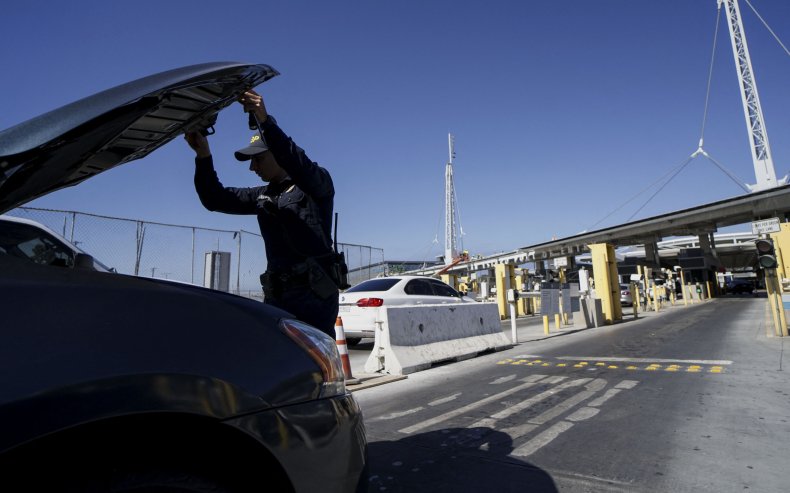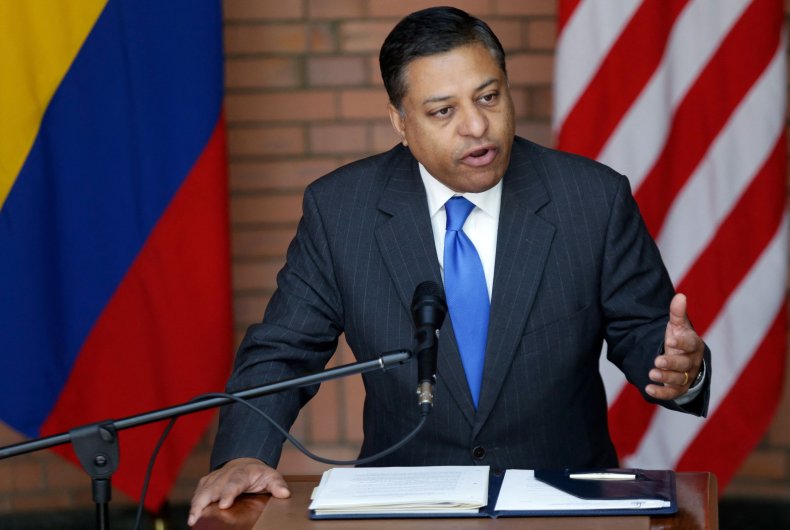The Biden administration is moving forward with a plan to expand the use of high-tech inspection systems at the Southern border in an effort to reduce the flow of fentanyl and other drugs into the country, Newsweek has learned.
President Biden’s drug czar Rahul Gupta will travel to the border Thursday to tout the expansion of a scanning system at border checkpoints that allows U.S. Customs and Border Protection (CBP) to more efficiently inspect vehicles for narcotics and other contraband.
Congress approved funding for the technology, known as large-scale non-intrusive inspection systems in 2019, but the program has been slow to get off the ground since then. The Biden administration’s push to add more of the inspection systems now is the latest attempt to address a deadly opioid crisis that kills tens of thousands of people in the United States each year.
“The goal is to make sure that every vehicle, regardless of [whether it’s] cargo or passenger, that needs to get scanned, gets scanned,” Gupta, the director of the Office of National Drug Control Policy, told Newsweek in an interview.
The scanners, which can check vehicles faster than agents doing physical searches, are currently used to inspect air cargo entering the country. But just two percent of passenger vehicles and 17 percent of cargo vehicles that enter the U.S. at land ports of entry are scanned with the non-intrusive inspection technology, Gupta said.
Biden pledged to expand the scanning systems in his State of the Union speech earlier this year, and called for $305 million for the project in his fiscal year 2024 budget.
The administration is planning to add 123 new non-intrusive scanning systems at land points of entry on the Southern border by fiscal year 2026. The expansion would allow CBP to scan 40 percent of passenger cars and 70 percent of cargo vehicles, according to the White House.
On Thursday, Gupta will tour ports of entry in Nogales, Arizona that have implemented the new scanning systems. CBP tested the expanded use of scanning systems at two border facilities between October 2021 and last May, and seized 19,000 pounds of narcotics, including nearly 200 pounds of illicit fentanyl, Gupta said.
Experts touted the administration’s push for more drug enforcement measures at the Southern border even as they warned that more needs to be done to combat the crisis.
“Every tool that we have needs to be leveraged in order to slow the fentanyl supply” coming into the country, said Sharon Walsh, the director of the Center for Drug and Alcohol Research at the University of Kentucky College of Medicine.

Sandy Huffaker/AFP via Getty Images
Most fentanyl consumed in the U.S. is smuggled into the country by Mexican cartels that make the drug using precursor chemicals imported from China and other countries, and they often rely on American citizens to drive the contraband across the Southern border, according to experts and U.S. government investigations.
CBP’s Office of Field Operations seized 14,000 pounds of fentanyl at ports of entry on the Southern border in fiscal year 2022, according to agency data, The Drug Enforcement Administration said that overall, 379 million deadly doses of fentanyl were seized last year, enough to kill every American. Fentanyl, which is highly addictive, is 50 times more powerful than heroin, according to the DEA.
Improved security at entry points along the U.S.-Mexico border could make a difference, said Vanda Felbab-Brown, a senior fellow in the Strobe Talbott Center for Security, Strategy, and Technology at Brookings.
Boosting inspections won’t stop the “fentanyl flow completely,” Felbab-Brown said. “But it’s an area where” the U.S. government can make an impact, she added.
Biden and his recent predecessors have struggled to contain an explosion in opioid use in the past three decades.
Since 1999, more than 930,000 people in the United States have died from a drug overdose, according to the Centers for Disease Control and Prevention. The overdose death rate for fentanyl has gone up dramatically in recent years, federal data shows.
Last year alone, nearly 110,000 people in the U.S. died from a drug overdose, according to provisional data released earlier this year by the CDC. Synthetic opioids, led by fentanyl, accounted for approximately 75 percent of the deaths, the agency found.
Biden has spoken out about the opioid crisis repeatedly since taking office. He laid out a comprehensive plan, which included calling for more scanning systems at the Southern border, in his State of the Union address in February.
But the White House has faced increased pressure to act since Republicans assumed control of the House in January.
House Speaker Kevin McCarthy blasted Biden’s handling of the crisis during a border trip to Arizona earlier this year. McCarthy argued that Mexican cartels were exploiting Biden’s border policies to bring more fentanyl into the United States.
“We’re going to fight to fix this problem,” McCarthy said at the time.
The House passed legislation in May that would permanently list fentanyl-related drugs as Schedule I controlled substances, the highest illegal drug classification. The bill, which drew bipartisan support and was endorsed by the Biden administration, is being debated in the Senate.

Juan Pablo Pino/AFP via Getty Images
Democratic Senator Gary Peters of Michigan and Republican Senator John Cornyn of Texas introduced separate legislation earlier this month to increase the use of non-intrusive scanning systems at ports of entry.
“[The systems will] better protect our communities from illicit drugs like fentanyl, while also enabling CBP to efficiently process legitimate commerce that keeps our economy moving,” Peters said in a statement.
The Biden administration has also taken several other steps on its own to reduce the flow of illicit drugs into the country and improve treatment options.
The administration rolled out new federal guidelines in April, 2021 to make buprenorphine, an opioid treatment medication, more readily available. Last year the Department of Health and Human Services announced $1.5 billion in funding for states to improve opioid treatment and recovery programs.
In recent months the Food and Drug Administration has also approved Narcan and Nalmefene, medications designed to treat opioid overdoses.
“That’s a lot of movement in a fairly short period of time, and it has the potential to change the treatment landscape,” Walsh said.
Still, others argued the Biden administration should adopt more aggressive measures, such as the use of so-called intrusive screening, to stop more fentanyl and other drugs from entering the U.S. in the first place.
“Even if intrusive inspections cause economic pain to the U.S. and Mexico, it’s worthwhile,” Felbab-Brown said.
In his interview with Newsweek, Gupta argued the Biden administration’s plan for curbing fentanyl trafficking would pay off.
“We’re at an inflection point,” he said, “and we need to double down on what works.”

